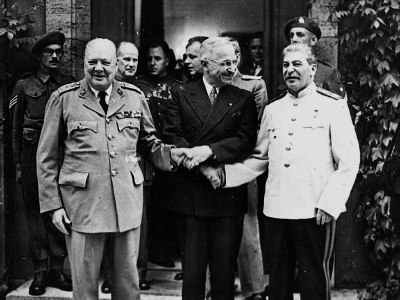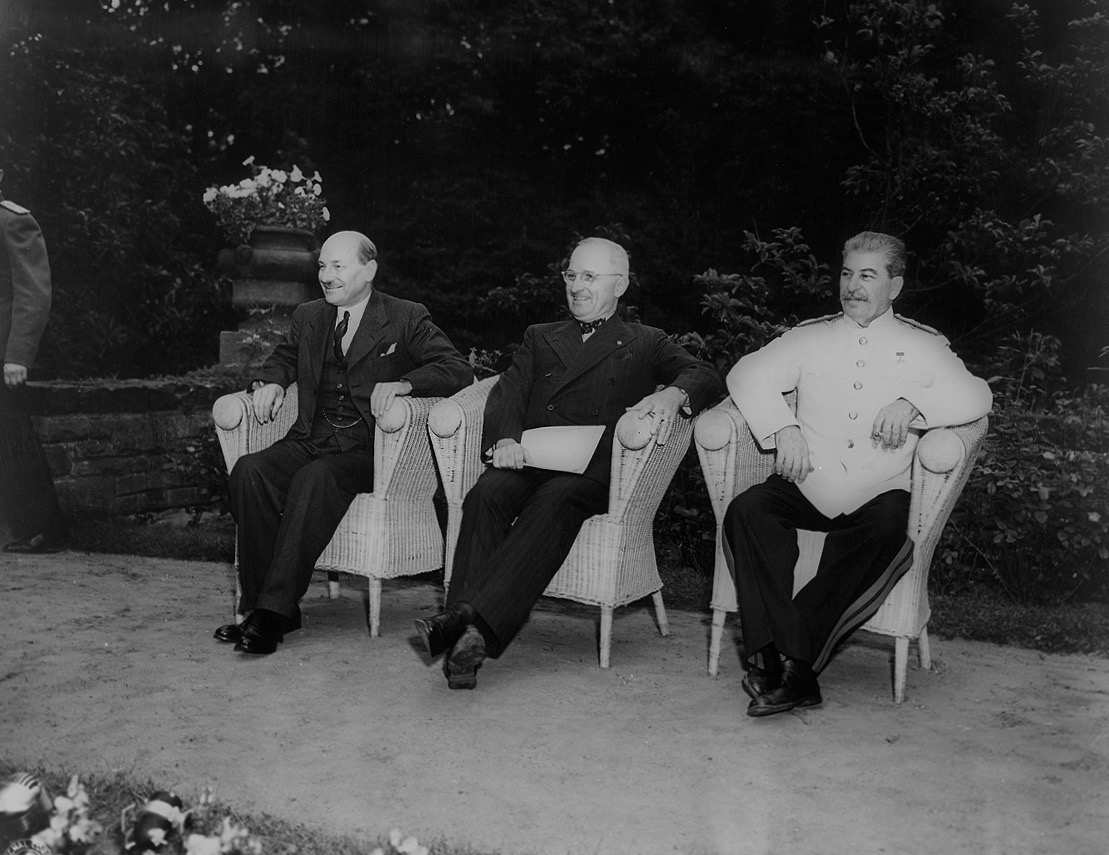At the Allied Conference, Truman—flanked by aggressive anti-communist Secretary of State James Byrnes—was a new factor for Stalin and Churchill alike. After Churchill’s defeat, the piqued ex-leader declined Attlee’s invitation to accompany him to the sessions. Stalin must have relished being the only of the original Big Three to survive the war.

They met in the soaring central hall, where I felt dwarfed: a three-story ceiling with simulated thick oak beams, a monumental two-story oak staircase with vinous carvings, a two-story bay window with 98 leaded panes looking toward the Heiliger See. The round table sat the Big Three and a dozen key advisors; smaller tables handled aides, translators, and transcribers.
Their agenda was as tangled as their expectations. The Allies were at victory’s threshold. But contradictory demands were unraveling the alliance. An initially nervous Truman, told of the successful atomic bomb test in New Mexico, tried to impress Stalin by hinting about the new super weapon; blasé Stalin, thanks to his spies, already knew. Truman talked tough on Eastern Europe and reneged on agreements FDR made with Stalin about Asia, feeling he no longer needed a Soviet “second front” against Japan. But Stalin’s troops held Eastern Europe and half of Germany; he hoped for Communist governments in Italy, France, and Greece; and he had 40 divisions bordering Manchuria. After paying the highest price of the Allies in blood and treasure, and knowing the American public was war-weary, he nodded at provisos, like a democratic Poland and open Manchurian ports, that he felt sure he could wait out.
I stood at the heavy mahogany desk and carved armchair in Stalin’s office, the former crown princess’s salon, where she’d watch her children play outside, the lake shimmering beyond, and wondered what he saw when he considered the view.
The Potsdam Agreement’s plan for postwar Germany outlined goals like disarmament, de-Nazification, and de-industrialization, but handed them over to an Allied control council. Each military governor ran his country’s occupation zone; anything pertaining to the four German occupied zones required unanimous agreement. Escalating stalemates after the conference eventually produced the Berlin face-off and divided Germany.
The separate Potsdam Declaration, threatening Japan’s “prompt and utter destruction” unless it surrendered unconditionally, was issued on July 26. The Japanese were silent. Truman used the A-bombs. Stalin’s forces invaded Manchuria on August 9—with Hokkaido, one of Japan’s home islands, next in line. The Japanese had hoped Stalin would negotiate an armistice for them with the Allies; finally, they capitulated.
And the Cold War, I thought as I stood on the path where the Berlin Wall once stood, was underway.

When You Go
Potsdam is a pleasant 20-minute ride from Berlin on the S7 line of the S-Bahn railway—perfect for day tripping.
Where to Eat: In Potsdam, lunch on savory borscht and salmon blinis at the Alexandrowka Museum café (Russische Kolonie 1, alexandrowka.de). Afternoons, the traditional Café Heider (29 Friedrich-Ebertstrasse, cafeheider.de) serves Obstler Schnapps (distilled from apples and pears) and Berliner Weiss mit Schuss (wheat beer with raspberry or woodruff cordial). Dinner in Berlin means Savignyplatz, an international restaurant hub on the S7 line. Moon Thai (Knesebeckstrasse 15, moonthai-restaurant.de) attracts an arty crowd with tasty curries. Good Friends (Kantstrasse 153) has a tacky exterior and fab Chinese food. Elegant but reasonable Lubitsch (Blieibtreu-strasse 47, restaurant-lubitsch.de) finesses international dishes alongside Wiener Schnitzel and Spargel (big white asparagus).
What Else to See: On the S7 between Berlin and Potsdam is Wannsee; sparkling beaches (one ”inland” has a nudist area), boating, parks, trails, and palaces dapple the UNESCO World Heritage Site. On January 20, 1942, senior Nazi officials, including Reinhard Heydrich and Adolf Eichmann, met at the Wannsee Villa to plan the Final Solution; it is now a memorial center.
[hr]
Gene Santoro is the reviews editor for World War II and American History, and covers pop culture for the New York Daily News. His current project deals with U.S. State Department cultural tours. Potsdam and its conference—and their fascinating contradictions—first struck him 30 years ago, when he was a Fulbright Scholar living in Italy and visited West Berlin.





